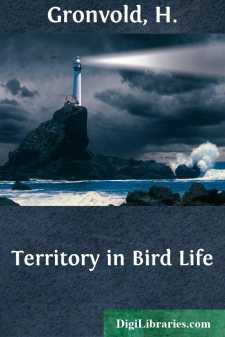Categories
- Antiques & Collectibles 13
- Architecture 36
- Art 48
- Bibles 22
- Biography & Autobiography 813
- Body, Mind & Spirit 142
- Business & Economics 28
- Children's Books 15
- Children's Fiction 12
- Computers 4
- Cooking 94
- Crafts & Hobbies 4
- Drama 346
- Education 46
- Family & Relationships 57
- Fiction 11828
- Games 19
- Gardening 17
- Health & Fitness 34
- History 1377
- House & Home 1
- Humor 147
- Juvenile Fiction 1873
- Juvenile Nonfiction 202
- Language Arts & Disciplines 88
- Law 16
- Literary Collections 686
- Literary Criticism 179
- Mathematics 13
- Medical 41
- Music 40
- Nature 179
- Non-Classifiable 1768
- Performing Arts 7
- Periodicals 1453
- Philosophy 64
- Photography 2
- Poetry 896
- Political Science 203
- Psychology 42
- Reference 154
- Religion 513
- Science 126
- Self-Help 84
- Social Science 81
- Sports & Recreation 34
- Study Aids 3
- Technology & Engineering 59
- Transportation 23
- Travel 463
- True Crime 29
Territory in Bird Life
by: H. Gronvold
Description:
Excerpt
CHAPTER I
INTRODUCTION
In his Manual of Psychology Dr Stout reminds us that "Human language is especially constructed to describe the mental states of human beings, and this means that it is especially constructed so as to mislead us when we attempt to describe the working of minds that differ in a great degree from the human."
The use of the word "territory" in connection with the sexual life of birds is open to the danger which we are here asked to guard against, and I propose, therefore, before attempting to establish the theory on general grounds, to give some explanation of what the word is intended to represent and some account of the exact position that representation is supposed to occupy in the drama of bird life.
The word is capable of much expansion. There cannot be territories without boundaries of some description; there cannot well be boundaries without disputes arising as to those boundaries; nor, one would imagine, can there be disputes without consciousness as a factor entering into the situation; and so on, until by a simple mental process we conceive of a state in bird life analogous to that which we know to be customary amongst ourselves. Now, although the term "breeding territory," when applied to the sexual life of birds, is not altogether a happy one, it is difficult to know how otherwise to give expression to the facts observed. Let it then be clearly understood that the expression "securing a territory" is used to denote a process, or rather part of a process, which, in order to insure success to the individual in the attainment of reproduction, has been gradually evolved to meet the exigencies of diverse circumstances. Regarded thus, we avoid the risk of conceiving of the act of securing a territory as a detached event in the life of a bird, and avoid, I hope, the risk of a conception based upon the meaning of the word when used to describe human as opposed to animal procedure.
Success in the attainment of reproduction is rightly considered to be the goal towards which many processes in nature are tending. But what is meant by success? Is it determined by the actual discharge of the sexual function? So many and so wonderful are the contrivances which have slowly been evolved to insure this discharge, that it is scarcely surprising to find attention focused upon this one aspect of the problem. Yet a moment's reflection will show that so limited a definition of the term "success" can only be held to apply to certain forms of life; for where the young have to be cared for, fostered, and protected from molestation for periods of varying lengths, the actual discharge of the sexual function marks but one stage in a process which can only succeed if all the contributory factors adequately meet the essential conditions of the continuance of the species.
Securing a territory is then part of a process which has for its goal the successful rearing of offspring. In this process the functioning of the primary impulse, the acquirement of a place suitable for breeding purposes, the advent of a female, the discharge of the sexual function, the construction of the nest, and the rearing of offspring follow one another in orderly sequence....


